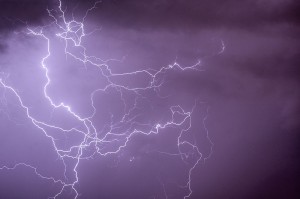18 December 2014
Lightning Bolts May have Jolted Life on Earth
Posted by kwheeling
By James Urton
Michael Wong wants to understand how life could evolve on other worlds. A graduate student in planetary sciences at the California Institute of Technology, he usually focuses on planetary atmospheres. But recently, his quest took Wong to a strange, hostile setting: the bottom of an acidic ocean on Earth, 4 billion years ago.

Lightning was likely sufficient to seed ancient oceans for biochemical reactions, according to new results announced this week at the American Geophysical Union’s Fall Meeting.
Credit: Florent Chouffot
Life may have bubbled out of the complex chemical reactions that occurred among rocks, minerals and gases in these acidic oceans less than a billion years after Earth formed. Back then, the high carbon dioxide and proton levels in the deep sea, combined with hydrogen gases and methane from submarine hydrothermal vents, probably created a friendly environment for simple biochemical reactions to form the first cells, according to theories first proposed decades ago and currently studied by Wong’s colleagues Yuk Yung at Caltech and Michael Russell at the Jet Propulsion Laboratory. Wong wanted to know if the ocean of ancient Earth really did harbor all the ingredients necessary for life, and whether atmospheric conditions may have helped.
“To me, it makes more sense to focus on the deep ocean,” said Wong, citing the gases and chemical compounds that were prevalent on Earth 4 billion years ago. Past studies showed that the chemical brew of these ancient, underwater vents had all the components needed for potential life, said Wong, except one.
“Nitrates. We weren’t sure if enough nitrates were present in the ocean,” he said.
Wong’s work, which he presented this week at the American Geophysical Union’s Fall Meeting, provides a clear answer. Nitrates and nitrites are simple nitrogen-containing chemical compounds the ancient hydrothermal broth needed to drive biochemical reactions. Wong modeled whether Earth’s ancient atmosphere, which contained abundant nitrogen gas, could have been a source for nitrates or nitrites that were missing from the ancient ocean.
“This gas would’ve needed to be converted into nitrates or nitrites, and that’s what I looked at,” said Wong.
Wong modeled whether the ancient atmosphere had enough lightning and ultraviolet radiation to convert nitrogen gas, water vapor, and carbon dioxide into nitrates and nitrites, which would fall to the ocean in rain. All the different types of atmospheric lightning he tested gave the oceans a bumper crop of nitrates or nitrites.
“So, in less than a million years, this system would have been set up in the deep ocean to drive these chemical reactions,” said Wong.
Despite his current focus on ancient Earth, Wong hopes that this model will inform investigations of life on other planets.
“Once we know the ancient chemical conditions on Mars or on Venus, we might be able to tell whether life could have evolved there,” he said. “Then we can look at these [water-rich] exoplanets with dense atmospheres and ask the same questions.”
James Urton is a science communication graduate student at UC Santa Cruz.










 GeoSpace is a blog on Earth and space science, managed by AGU’s Public Information staff. The blog features posts by AGU writers and guest contributors on all sorts of relevant science topics, but with a focus on new research and geo and space sciences-related stories that are currently in the news.
GeoSpace is a blog on Earth and space science, managed by AGU’s Public Information staff. The blog features posts by AGU writers and guest contributors on all sorts of relevant science topics, but with a focus on new research and geo and space sciences-related stories that are currently in the news.